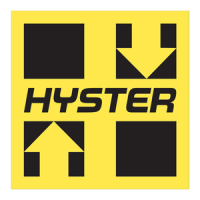4000 SRM 481 Description
General
This section has the description and repair in-
structions for the lift cylinders used on the
N30FR, N40/45FR, N50FA, R30ES, N30XMH,
N30XMH
2
, N25XMDR3, N30/40XMR3, N50XMA3,
N30XMDR3, N45XMR3, N30XMXDR3, N45XMXR3,
V30ZMD, W25-30ZA
2
, W30-40ZA, W25-30-40ZC,
W20-30ZR, N30-35ZDR, N35-40-45ZR, N30ZDRS,
and N35-40ZRS masts. See the section Reach Car-
riages 4500 SRM 971 or Reach Carriages 4500
SRM 1196 for hydraulic cylinder repair instructions
for the reach carriages.
Description
The two-stage masts generally have two main lift
cylinders. However, models W25/30ZA
2
, W30/40ZA,
and W25/30/40ZC lift trucks with 2 Stage LFL have
only one main lift cylinder centered in the mast. The
three-stage FFL models have two main lift cylinders,
as well as a shorter free-lift cylinder. See Figure 1.
All of these lift cylinders are single-acting cylinders.
The hydraulic force is applied only in one direction.
When hydraulic oil enters one end of the lift cylinder,
the hydraulic force extends the piston rod. When the
force is removed, the weight of the mast components
and carriage causes the piston rod to retract.
These cylinders are also single-stage lift cylinders.
A single-stage lift cylinder has only one rod. See
Figure 1. There are two types of single-stage cylin-
ders used on these lift trucks. One type is the piston
cylinder. The other type is a displacement cylinder.
Trucks may be equipped with either piston or dis-
placement type cylinders or a combination of both.
Piston cylinders operate by hydraulic oil entering
under the piston of the cylinder rod. Seals are used
in the piston to keep the oil from moving from under
the piston to the top of the piston. As the hydraulic
oil raises the piston, the air within the upper part
of the cylinder is compressed into a chamber of the
piston rod. Any oil that is above the piston will be
forced, under pressure, through a check valve back
under the piston.
Displacement cylinders operate by hydraulic oil
entering the cylinder and displacing the rod. Seals
are located in the retainer, and the entire cylinder is
filled with oil. This type of cylinder will have a bleed
screw located near the top of the cylinder to remove
air from the cylinder. The rod of displacement cylin-
ders is almost the size of the inside of the shell. See
Figure 1.
The design and repairs for these displacement cylin-
ders are similar to the other lift cylinders in this sec-
tion. A displacement cylinder does not have a piston
or piston seal. The rod diameter is almost the same
as the inside diameter of the cylinder shell. There are
wear rings on the rod that are the bearings between
the rod and the walls of the cylinder. The wiper seal
atthetopofthecylinderisalsothehigh-pressure
seal for these cylinders. See Figure 3.
1

